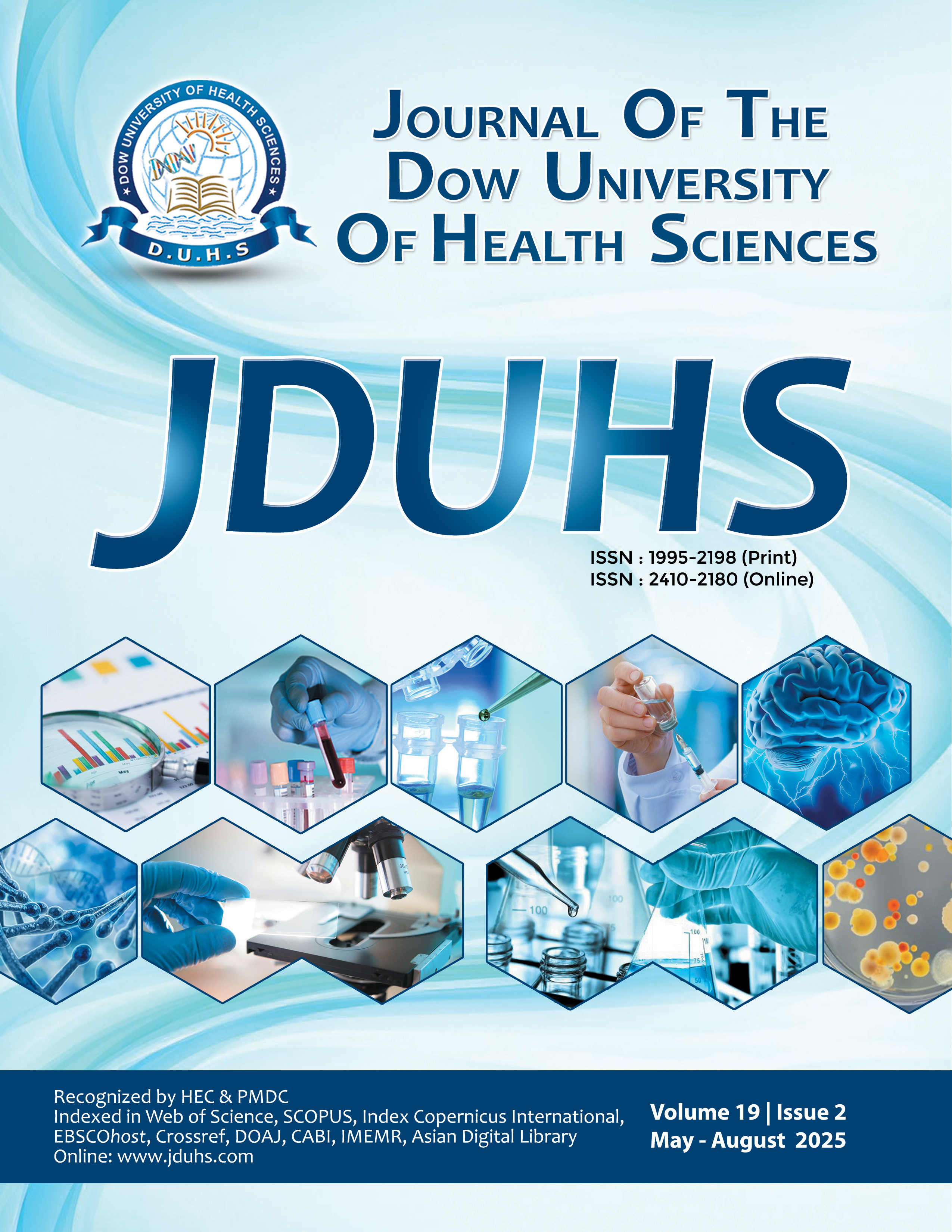Association between Clinical Presentations and Magnetic Resonance Imaging Findings in Single Level Lumbar Disc Prolapse in a Tertiary Care Hospital
DOI:
https://doi.org/10.36570/jduhs.2025.2.2494Keywords:
Intervertebral Disc Displacement, Lumbar Vertebrae, Report, Time, Hospital, Magnetic Resonance Imaging, technology., Flat shoes, knee, low back pain, pes planus., Neurologic ExaminationAbstract
Objective: To determine the frequency of clinical presentations (neurological signs and symptoms) and assess their association with magnetic resonance imaging (MRI) findings in patients with single-level lumbar disc prolapse.
Methods: This cross-sectional study was conducted at the Department of Neurosurgery, Shifa International Hospital, Islamabad, from August 2024 to December 2024. The study included adults over 18 years, with or without lower back or leg pain, who consented to MRI of the lumbosacral spine. Neurological signs and symptoms, including numbness, paresthesia, neurogenic claudication, motor weakness, and diminished reflexes, were assessed. Neurological deficit was defined as the presence of one or more symptoms. MRI findings were categorized by disc level, type of disc prolapse, and nerve root compression.
Results: Out of 85 patients with single-level disc prolapse, numbness was the most common clinical symptom reported in 44 (51.8%) patients. MRI most commonly revealed involvement at L5/S1 and L4/L5 i.e., 43 (50.6%) and 34 (40.0%). Neurological deficit was observed in 66 (77.6%) patients. There was no significant association between neurological deficit and disc level (p-value =0.913), character of disc bulge (p-value =0.460), and nerve root compression (p-value =0.348). However, patients clinically diagnosed with lumbar disc prolapse had a significantly higher prevalence of neurological deficit (p-value < 0.001).
Conclusion: Over three-fourths of patients with single-level lumbar disc prolapse had neurological deficits, with numbness being the most common symptom. No significant link was found between MRI findings and neurological deficits, but clinical diagnosis was strongly associated with them.
Downloads
References
Wu A, March L, Zheng X, Huang J, Wang X, Zhao J, et al. Global low back pain prevalence and years lived with disability from 1990 to 2017: estimates from the Global Burden of Disease Study 2017. Ann Transl Med 2020; 8:299. doi:10.21037/atm.2020.02.175
Majidi H, Shafizad M, Niksolat F, Mahmudi M, Ehteshami S, Poorali M, et al. Relationship between magnetic resonance imaging findings and clinical symptoms in patients with suspected lumbar spinal canal stenosis: a case-control study. Acta Inform Med 2019; 27:229-33. doi:10.5455/aim.2019.27.229-233
Nasir H, Sarwar MU, Qureshi SN, Rehman M, Maqsod A, Saif S. Correlation of clinical manifestation of lumbar disc prolapse with magnetic resonance imaging findings among adult patients. J Univ Med Dent Coll 2022; 13:508-12. doi:10.37723/jumdc.v13i4.764
Azeem N, Anwar M, Kadr S. Magnetic resonance imag-ing of lumbar spine in lower backache: a comparative study on gender basis. J Bahria Uni Med 2022; 12:207-11.
Orhurhu VJ, Chu R, Gill J. Failed Back Surgery Syndrome. [Updated 2023 May 1]. In: StatPearls [Internet]. Treasure Island (FL): StatPearls Publishing; 2024. Available from: https://www.ncbi.nlm.nih.gov/books/NBK539777/.
Khorami AK, Oliveira CB, Maher CG, Bindels PJE, Mach-ado GC, Pinto RZ, et al. Recommendations for diagnosis and treatment of lumbosacral radicular pain: a systematic review of clinical practice guidelines. J Clin Med 2021; 10:2482. doi:10.3390/jcm10112482
Janardhana AP, Rajagopal, Rao S, Kamath A. Correlation between clinical features and magnetic resonance imaging findings in lumbar disc prolapse. Indian J Orthop 2010; 44:263-9. doi:10.4103/0019-5413.65148
Rijal A, Paudel M. Correlation between clinical features and findings observed on magnetic resonance imaging in patients with lumbar disc prolapse. Asian J Orthop Res 2020; 3:26-33.
Vroomen PC, Krom MC, Wilmink JT, Kester AD, nottne-rus JA. Diagnostic value of history and physical examination in patients suspected of lumbosacral nerve root compression. J Neurol Neurosurg sychiatry 2002; 72:630-4. doi:10.1136/jnnp.72.5.630
Modic MT, Ross JS. Lumbar degenerative disk disease. Radiology 2007; 245:43-61. doi:10.1148/radiol.2451051706
Martel JV, Martinez-Sanchez RT, Cebada-Chaparro E, Horcajadas AL, Perez-Fernandez E. Diagnostic accuracy of lumbar CT and MRI in the evaluation of chronic low back pain without red flag symptoms. Radiologia (Engl Ed) 2023; 65:S59-70. doi:10.1016/j.rxeng.2023.02.004
Din RU, Cheng X, Yang H. Diagnostic role of magnetic resonance imaging in low back pain caused by vertebral endplate degeneration. J Magn Reson Imaging 2022; 55:755-71. doi:10.1002/jmri.27858
Kasch R, Truthmann J, Hancock MJ, Maher CG, Otto M, Nell C, et al. Association of lumbar mri findings with current and future back pain in a population-based cohort study. Spine (Phila Pa 1976) 2022;47:201-11. doi:10.1097/BRS.0000000000004198
Graaf JW, Kroeze RJ, Buckens CF, Lessmann N, van Hoff ML. MRI image features with an evident relation to low back pain: a narrative review. Eur Spine J 2023; 32:1830-41. doi:10.1007/s00586-023-07602-x
Baker ADL. Abnormal magnetic-resonance scans of the lumbar spine in asymptomatic subjects: a prospective investigation. In: Banaszkiewicz P, Kader D, editors. Classic papers in orthopaedics. London: Springer; 2014. p. 409-12. doi:10.1007/978-1-4471-5451-8_60
Kjaer P, Leboeuf-Yde C, Korsholm L, Sorensen JS, Bendix T. Magnetic resonance imaging and low back pain in adults: a diagnostic imaging study of 40-year-old men and women. Spine (Phila Pa 1976) 2005; 30:1173-80. doi:10.1097/01.brs.0000162396.97739.76
Woolf CJ. Central sensitization: implications for the diagnosis and treatment of pain. Pain 2011; 152:S2-15. doi:10.1016/j.pain.2010.09.030
Chiewvit P, Danchaivijitr N, Sirivitmaitrie K, Chiewvit S, Thephamongkhol K. Does magnetic resonance imaging give value-added than bone scintigraphy in the detection of vertebral metastasis? J Med Assoc Thai 2009; 92:818-29.
Rehman L, Khaleeq S, Hussain A, Ghani E, Mushtaq M, Zaman K. Correlation between clinical features and magnetic resonance imaging findings in patients with lumbar disc herniation. J Postgrad Med Inst 2011; 21:65-70.
Shaikh A, Khan SA, Hussain M, Somro S, Adel H, Adil SO, et al. Prevalence of lumbosacral transitional vertebra in individuals with low back pain: evaluation using plain radiography and magnetic resonance imaging. Asian Spine J 2017; 11:892-97. doi:10.4184/asj.2017.11.6.892
Published
How to Cite
Issue
Section
License
Copyright (c) 2025 Muneeza Adam Khatri

This work is licensed under a Creative Commons Attribution-NonCommercial 4.0 International License.
Articles published in the Journal of Dow University of Health Sciences are distributed under the terms of the Creative Commons Attribution Non-Commercial License https://creativecommons.org/ licenses/by-nc/4.0/. This license permits use, distribution and reproduction in any medium; provided the original work is properly cited and initial publication in this journal. ![]()





